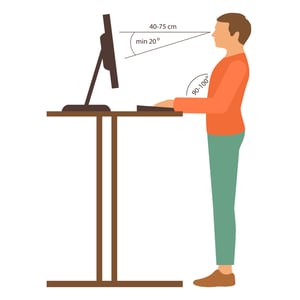Designing and building a lab can be challenging enough, but factor in the added time and cost of incorporating ergonomics, and it can seem like overkill.
Or is it?
What Is Ergonomics?
Ergonomics, sometimes referred to as human factors engineering, is the scientific discipline concerned with designing and arranging objects, environments and systems to fit the capabilities and limitations of the human body.
arranging objects, environments and systems to fit the capabilities and limitations of the human body.
But what does this mean and how does it relate to your laboratory space? Ergonomics looks at how employees interact with their workspaces, tools and tasks to optimize comfort, health and safety, and efficiency. Essentially, the goal of ergonomics is to create environments and systems that promote well-being and productivity by minimizing physical strain and cognitive load while maximizing performance.
As a lab manager, what happens if you don’t prioritize ergonomics in the workplace? It could spell bad news for your lab’s productivity.
When workers’ bodies are subjected to unnatural movements repeatedly, they are at higher risk for musculoskeletal disorders or injuries. These injuries can affect the muscles, tendons, ligaments, nerves and joints, leading to discomfort, pain and reduced functionality.
Common ergonomic risk factors include:
- Awkward postures
- Repetitive motions
- Excessive force
- Prolonged static positions
For example, working at a computer station with improper chair height or keyboard placement can lead to strained neck muscles, while repetitive lifting tasks without proper body mechanics can cause back injuries.
Some of the most recent ergonomics research shows that the rate of workplace musculoskeletal injuries was nearly 27 per 10,000 full-time workers in 2020. In 2021, total workers’ compensation claims costs included $13.3 billion for overexertion involving outside sources, $4.7 billion for awkward postures and $1.7 billion for repetitive motions involving microtasks or small tasks like typing.
By understanding how ergonomic factors focus on putting the body in a neutral position and how they contribute to musculoskeletal health, your lab can implement preventive measures and ergonomic interventions to mitigate the risk of injury and promote employee well-being.
Is Ergonomics New?
Believe it or not, the concept of ergonomics likely started around the time that humans created tools, because they were constantly looking for new and better ways to make tools that made their tasks easier. We only need to look at the evolution in the look and shape of those tools to see early ergonomics in practice.
However, the idea of ergonomics really started to take off during the industrial revolution of the 1900s when production was dependent on human power and motion, making the efficiency of man and machine a priority.
After World War II ended, the focus of ergonomics had expanded to worker safety as well as productivity. Labor unions entered the picture and placed a greater emphasis on the safety of employees.
Does Your Lab Need To Focus On Ergonomics?
While your lab workers may not operate in a warehouse or factory where they are lifting heavy boxes and equipment,.png?width=300&height=251&name=Untitled%20design%20(75).png) they are likely still at risk for injuries based on repetitive movements, long periods of sitting or standing, and working in other at-risk positions.
they are likely still at risk for injuries based on repetitive movements, long periods of sitting or standing, and working in other at-risk positions.
Here are some questions to ask yourself:
- Do my lab employees sit a lot or stand for long periods?
- Do my lab employees work on computers where there might be a need for lighting to limit glare?
- Do my lab employees view through microscopes that have a neutral head position?
- Do my lab employees have to reach more than 18 inches for anything?
- Do my lab employees have to lift heavy boxes of supplies, such as bottles of chemicals?
- Are workstations and equipment adjustable to accommodate employees of different heights and body sizes?
- Are there any repetitive tasks in the lab that could lead to strain or injury over time?
- Are there adequate rest breaks provided for employees engaged in tasks that require prolonged concentration or physical exertion?
- Is there sufficient space and organization to allow for proper movement and workflow efficiency within the lab?
- Are there any potential hazards in the lab environment that could pose ergonomic risks, such as slippery floors or poorly designed equipment?
- Are employees trained in proper ergonomic techniques for tasks such as lifting, carrying Are there opportunities for job rotation or task variation to reduce the likelihood of repetitive strain injuries?
- Are there mechanisms in place for employees to report ergonomic concerns or discomfort, and is there a process for addressing these issues promptly?
- Are there ergonomic accessories or tools available to support employees in performing their tasks more comfortably and safely, such as adjustable industrial furniture chairs, footrests or anti-fatigue mats?
- Are ergonomic assessments regularly conducted to identify areas for improvement and ensure ongoing attention to ergonomic considerations in the lab environment?
These are just some of the questions that if you answered yes, indicate a need for you to include laboratory ergonomics in your design process.
What Are Some Examples Of Ergonomic Lab Furniture?
If you’re redesigning a lab space or updating pieces of laboratory furniture to enhance the safety and well being of your staff, here are some examples of ergonomically-friendly lab furniture commonly found in modern laboratory settings:
- Adjustable Lab Chairs: Lab chairs with adjustable features such as seat height, backrest angle and armrests allow users to customize their seating position at a lab bench for optimal comfort and support during extended periods of work.
- Adjustable-Height Workbenches: Adjustable-height workbenches enable users to modify the height of their work surface, accommodating different tasks and user preferences. These benches can facilitate both sitting and standing work positions, promoting ergonomic flexibility and reducing the risk of musculoskeletal strain.
- Laboratory Desks with Monitor Arms: Desks equipped with monitor arms provide ergonomic support for computer workstations in the lab. Monitor arms allow users to adjust the height, tilt and distance of their screens, helping to minimize neck and eye strain by maintaining proper viewing angles and posture.
- Mobile Industrial Workbench: Mobile workstations equipped with wheels or casters offer flexibility and adaptability in lab environments where tasks require frequent movement between different areas. These ergonomic solutions enable users to bring their work tools and equipment to where they are needed, reducing the need for excessive reaching or stretching.
- Anti-Fatigue Mats: Anti-fatigue mats are designed to reduce discomfort and fatigue caused by prolonged standing on hard surfaces. These mats offer cushioning and support for lab personnel working at standing-height workstations, helping to alleviate pressure on the feet, legs and lower back.
- Ergonomic Laboratory Stools: Ergonomic laboratory stools feature contoured seats, adjustable height and footrests to promote comfortable and supported seating for lab technicians and researchers. These stools are designed to accommodate a range of tasks and workstations, allowing users to maintain proper posture and reduce fatigue during long periods of work.
- Task Lighting with Adjustable Arms: Task lighting with adjustable arms allows users to direct light precisely where it is needed, reducing glare and eyestrain during detailed or precision work tasks. Adjustable lighting fixtures can be positioned to minimize reflections and shadows, providing optimal visibility without causing discomfort or visual fatigue.
As you’re looking for a lab casework manufacturer, make sure you partner with a company that is experienced in creating customized pieces that meet the needs of your specific lab. Choosing a domestic supplier or manufacturer can also help reduce shipping times, the risk for customs issues and customer service problems.
By incorporating these examples of ergonomic lab furniture into laboratory design and workstation setups, organizations can create a safer, more comfortable, and efficient work environment for their personnel, ultimately supporting productivity and well-being.


